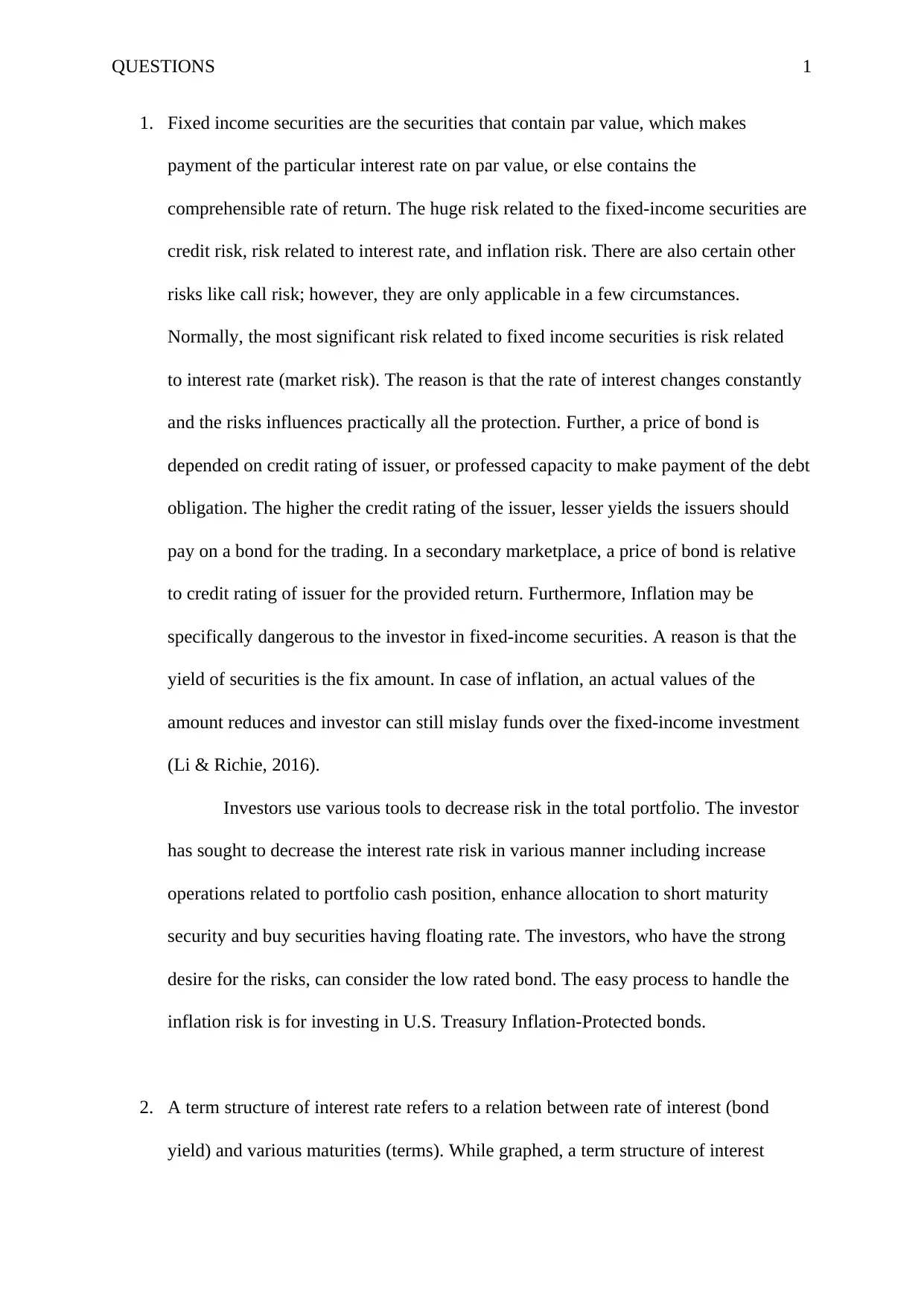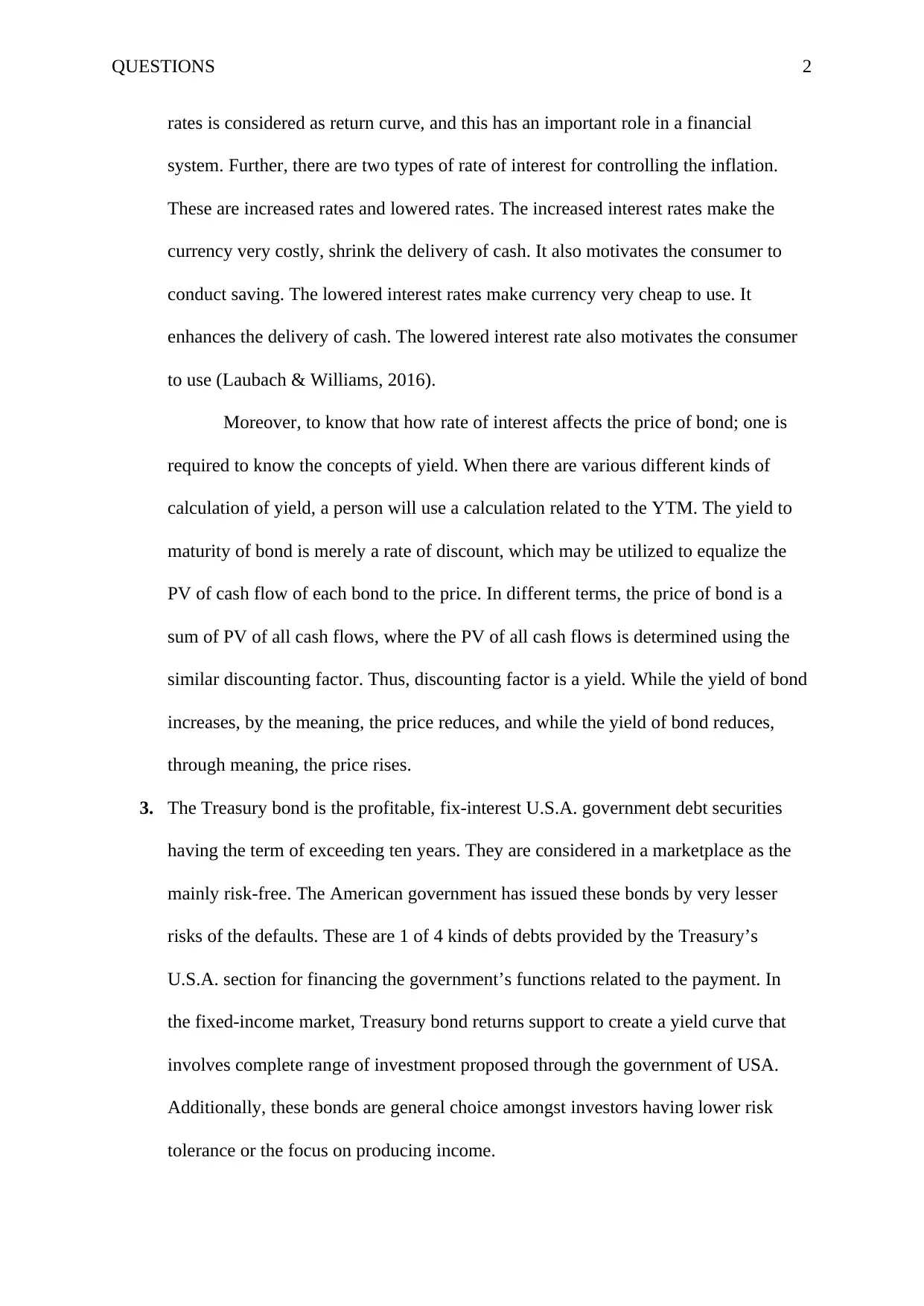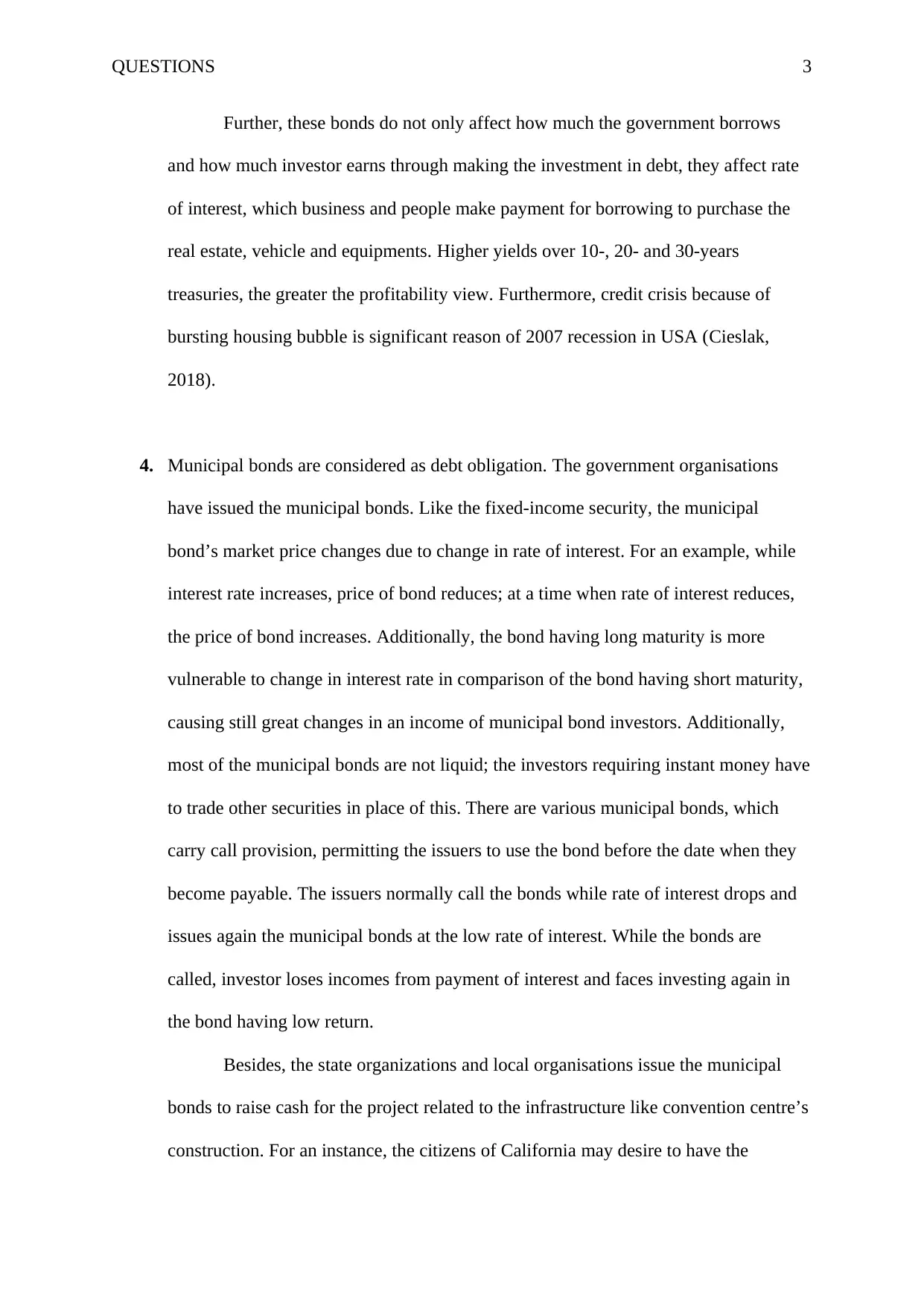Fixed Income Securities Analysis: Finance Module 7 Assignment
VerifiedAdded on 2022/12/15
|6
|1294
|409
Homework Assignment
AI Summary
This assignment comprehensively addresses key concepts in fixed income securities. It begins by defining fixed income securities and detailing associated risks like credit, interest rate, and inflation risks, along with strategies to mitigate these risks within a portfolio. The assignment then explains the term structure of interest rates, different types of interest rates, and their impact on bond pricing, including the role of yield to maturity. Following this, it explores U.S. Treasury bonds, their role in government financing, and their use by investors, along with the influence of the 2007 financial crisis. Finally, the assignment covers municipal bonds, discussing their usage by issuers and investors, associated risks and benefits, and provides examples of current municipal bonds, detailing their yields and risk profiles. The analysis incorporates relevant financial theories and current market dynamics to provide a thorough understanding of fixed income instruments.

Running head: QUESTIONS 0
finance
APRIL 26, 2019
student details:
finance
APRIL 26, 2019
student details:
Paraphrase This Document
Need a fresh take? Get an instant paraphrase of this document with our AI Paraphraser

QUESTIONS 1
1. Fixed income securities are the securities that contain par value, which makes
payment of the particular interest rate on par value, or else contains the
comprehensible rate of return. The huge risk related to the fixed-income securities are
credit risk, risk related to interest rate, and inflation risk. There are also certain other
risks like call risk; however, they are only applicable in a few circumstances.
Normally, the most significant risk related to fixed income securities is risk related
to interest rate (market risk). The reason is that the rate of interest changes constantly
and the risks influences practically all the protection. Further, a price of bond is
depended on credit rating of issuer, or professed capacity to make payment of the debt
obligation. The higher the credit rating of the issuer, lesser yields the issuers should
pay on a bond for the trading. In a secondary marketplace, a price of bond is relative
to credit rating of issuer for the provided return. Furthermore, Inflation may be
specifically dangerous to the investor in fixed-income securities. A reason is that the
yield of securities is the fix amount. In case of inflation, an actual values of the
amount reduces and investor can still mislay funds over the fixed-income investment
(Li & Richie, 2016).
Investors use various tools to decrease risk in the total portfolio. The investor
has sought to decrease the interest rate risk in various manner including increase
operations related to portfolio cash position, enhance allocation to short maturity
security and buy securities having floating rate. The investors, who have the strong
desire for the risks, can consider the low rated bond. The easy process to handle the
inflation risk is for investing in U.S. Treasury Inflation-Protected bonds.
2. A term structure of interest rate refers to a relation between rate of interest (bond
yield) and various maturities (terms). While graphed, a term structure of interest
1. Fixed income securities are the securities that contain par value, which makes
payment of the particular interest rate on par value, or else contains the
comprehensible rate of return. The huge risk related to the fixed-income securities are
credit risk, risk related to interest rate, and inflation risk. There are also certain other
risks like call risk; however, they are only applicable in a few circumstances.
Normally, the most significant risk related to fixed income securities is risk related
to interest rate (market risk). The reason is that the rate of interest changes constantly
and the risks influences practically all the protection. Further, a price of bond is
depended on credit rating of issuer, or professed capacity to make payment of the debt
obligation. The higher the credit rating of the issuer, lesser yields the issuers should
pay on a bond for the trading. In a secondary marketplace, a price of bond is relative
to credit rating of issuer for the provided return. Furthermore, Inflation may be
specifically dangerous to the investor in fixed-income securities. A reason is that the
yield of securities is the fix amount. In case of inflation, an actual values of the
amount reduces and investor can still mislay funds over the fixed-income investment
(Li & Richie, 2016).
Investors use various tools to decrease risk in the total portfolio. The investor
has sought to decrease the interest rate risk in various manner including increase
operations related to portfolio cash position, enhance allocation to short maturity
security and buy securities having floating rate. The investors, who have the strong
desire for the risks, can consider the low rated bond. The easy process to handle the
inflation risk is for investing in U.S. Treasury Inflation-Protected bonds.
2. A term structure of interest rate refers to a relation between rate of interest (bond
yield) and various maturities (terms). While graphed, a term structure of interest

QUESTIONS 2
rates is considered as return curve, and this has an important role in a financial
system. Further, there are two types of rate of interest for controlling the inflation.
These are increased rates and lowered rates. The increased interest rates make the
currency very costly, shrink the delivery of cash. It also motivates the consumer to
conduct saving. The lowered interest rates make currency very cheap to use. It
enhances the delivery of cash. The lowered interest rate also motivates the consumer
to use (Laubach & Williams, 2016).
Moreover, to know that how rate of interest affects the price of bond; one is
required to know the concepts of yield. When there are various different kinds of
calculation of yield, a person will use a calculation related to the YTM. The yield to
maturity of bond is merely a rate of discount, which may be utilized to equalize the
PV of cash flow of each bond to the price. In different terms, the price of bond is a
sum of PV of all cash flows, where the PV of all cash flows is determined using the
similar discounting factor. Thus, discounting factor is a yield. While the yield of bond
increases, by the meaning, the price reduces, and while the yield of bond reduces,
through meaning, the price rises.
3. The Treasury bond is the profitable, fix-interest U.S.A. government debt securities
having the term of exceeding ten years. They are considered in a marketplace as the
mainly risk-free. The American government has issued these bonds by very lesser
risks of the defaults. These are 1 of 4 kinds of debts provided by the Treasury’s
U.S.A. section for financing the government’s functions related to the payment. In
the fixed-income market, Treasury bond returns support to create a yield curve that
involves complete range of investment proposed through the government of USA.
Additionally, these bonds are general choice amongst investors having lower risk
tolerance or the focus on producing income.
rates is considered as return curve, and this has an important role in a financial
system. Further, there are two types of rate of interest for controlling the inflation.
These are increased rates and lowered rates. The increased interest rates make the
currency very costly, shrink the delivery of cash. It also motivates the consumer to
conduct saving. The lowered interest rates make currency very cheap to use. It
enhances the delivery of cash. The lowered interest rate also motivates the consumer
to use (Laubach & Williams, 2016).
Moreover, to know that how rate of interest affects the price of bond; one is
required to know the concepts of yield. When there are various different kinds of
calculation of yield, a person will use a calculation related to the YTM. The yield to
maturity of bond is merely a rate of discount, which may be utilized to equalize the
PV of cash flow of each bond to the price. In different terms, the price of bond is a
sum of PV of all cash flows, where the PV of all cash flows is determined using the
similar discounting factor. Thus, discounting factor is a yield. While the yield of bond
increases, by the meaning, the price reduces, and while the yield of bond reduces,
through meaning, the price rises.
3. The Treasury bond is the profitable, fix-interest U.S.A. government debt securities
having the term of exceeding ten years. They are considered in a marketplace as the
mainly risk-free. The American government has issued these bonds by very lesser
risks of the defaults. These are 1 of 4 kinds of debts provided by the Treasury’s
U.S.A. section for financing the government’s functions related to the payment. In
the fixed-income market, Treasury bond returns support to create a yield curve that
involves complete range of investment proposed through the government of USA.
Additionally, these bonds are general choice amongst investors having lower risk
tolerance or the focus on producing income.
⊘ This is a preview!⊘
Do you want full access?
Subscribe today to unlock all pages.

Trusted by 1+ million students worldwide

QUESTIONS 3
Further, these bonds do not only affect how much the government borrows
and how much investor earns through making the investment in debt, they affect rate
of interest, which business and people make payment for borrowing to purchase the
real estate, vehicle and equipments. Higher yields over 10-, 20- and 30-years
treasuries, the greater the profitability view. Furthermore, credit crisis because of
bursting housing bubble is significant reason of 2007 recession in USA (Cieslak,
2018).
4. Municipal bonds are considered as debt obligation. The government organisations
have issued the municipal bonds. Like the fixed-income security, the municipal
bond’s market price changes due to change in rate of interest. For an example, while
interest rate increases, price of bond reduces; at a time when rate of interest reduces,
the price of bond increases. Additionally, the bond having long maturity is more
vulnerable to change in interest rate in comparison of the bond having short maturity,
causing still great changes in an income of municipal bond investors. Additionally,
most of the municipal bonds are not liquid; the investors requiring instant money have
to trade other securities in place of this. There are various municipal bonds, which
carry call provision, permitting the issuers to use the bond before the date when they
become payable. The issuers normally call the bonds while rate of interest drops and
issues again the municipal bonds at the low rate of interest. While the bonds are
called, investor loses incomes from payment of interest and faces investing again in
the bond having low return.
Besides, the state organizations and local organisations issue the municipal
bonds to raise cash for the project related to the infrastructure like convention centre’s
construction. For an instance, the citizens of California may desire to have the
Further, these bonds do not only affect how much the government borrows
and how much investor earns through making the investment in debt, they affect rate
of interest, which business and people make payment for borrowing to purchase the
real estate, vehicle and equipments. Higher yields over 10-, 20- and 30-years
treasuries, the greater the profitability view. Furthermore, credit crisis because of
bursting housing bubble is significant reason of 2007 recession in USA (Cieslak,
2018).
4. Municipal bonds are considered as debt obligation. The government organisations
have issued the municipal bonds. Like the fixed-income security, the municipal
bond’s market price changes due to change in rate of interest. For an example, while
interest rate increases, price of bond reduces; at a time when rate of interest reduces,
the price of bond increases. Additionally, the bond having long maturity is more
vulnerable to change in interest rate in comparison of the bond having short maturity,
causing still great changes in an income of municipal bond investors. Additionally,
most of the municipal bonds are not liquid; the investors requiring instant money have
to trade other securities in place of this. There are various municipal bonds, which
carry call provision, permitting the issuers to use the bond before the date when they
become payable. The issuers normally call the bonds while rate of interest drops and
issues again the municipal bonds at the low rate of interest. While the bonds are
called, investor loses incomes from payment of interest and faces investing again in
the bond having low return.
Besides, the state organizations and local organisations issue the municipal
bonds to raise cash for the project related to the infrastructure like convention centre’s
construction. For an instance, the citizens of California may desire to have the
Paraphrase This Document
Need a fresh take? Get an instant paraphrase of this document with our AI Paraphraser

QUESTIONS 4
California Municipal Bond Fund. As well there are various municipal bonds, however
two very famous are revenue bond and bond having general obligation. The
bonds having general obligations are paid with tax taken by issuers. These bonds
are not secured. Normally, they have maturity of minimum ten years. Revenue
bonds are the bonds which paid with revenue produced through project financed with
proceed of bond like toll (Schwert, 2017).
California Municipal Bond Fund. As well there are various municipal bonds, however
two very famous are revenue bond and bond having general obligation. The
bonds having general obligations are paid with tax taken by issuers. These bonds
are not secured. Normally, they have maturity of minimum ten years. Revenue
bonds are the bonds which paid with revenue produced through project financed with
proceed of bond like toll (Schwert, 2017).

QUESTIONS 5
References
Cieslak, A. (2018). Short-rate expectations and unexpected returns in treasury bonds. The
Review of Financial Studies, 31(9), 3265-3306.
Laubach, T., & Williams, J. C. (2016). Measuring the natural rate of interest redux. Business
Economics, 51(2), 57-67.
Li, S., & Richie, N. (2016). Income smoothing and the cost of debt. China Journal of
Accounting Research, 9(3), 175-190.
Schwert, M. (2017). Municipal bond liquidity and default risk. The Journal of
Finance, 72(4), 1683-1722.
References
Cieslak, A. (2018). Short-rate expectations and unexpected returns in treasury bonds. The
Review of Financial Studies, 31(9), 3265-3306.
Laubach, T., & Williams, J. C. (2016). Measuring the natural rate of interest redux. Business
Economics, 51(2), 57-67.
Li, S., & Richie, N. (2016). Income smoothing and the cost of debt. China Journal of
Accounting Research, 9(3), 175-190.
Schwert, M. (2017). Municipal bond liquidity and default risk. The Journal of
Finance, 72(4), 1683-1722.
⊘ This is a preview!⊘
Do you want full access?
Subscribe today to unlock all pages.

Trusted by 1+ million students worldwide
1 out of 6
Related Documents
Your All-in-One AI-Powered Toolkit for Academic Success.
+13062052269
info@desklib.com
Available 24*7 on WhatsApp / Email
![[object Object]](/_next/static/media/star-bottom.7253800d.svg)
Unlock your academic potential
Copyright © 2020–2025 A2Z Services. All Rights Reserved. Developed and managed by ZUCOL.




